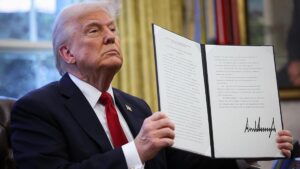“My heart is hurting. Why did Russia do this?” This are the words of Ulshin, a Ukrainian army commander, surveying the wreckage of what was once a school in Shyrokyne, in eastern Ukraine, on the frontline between the Ukrainian army and pro-Russian forces.
He was talking to Luke Harding, a Guardian foreign correspondent, who has been reporting extensively from the frontline, where he has found echoes of world war one in the muddy stalemate.
Here is his video report from the coastal city of Mariupol on preparations for a potential Russian attack. It’s also a powerful reminder that Ukraine has been at war with Russian-backed separatists in the Donbass region since 2014, with at least 14,000 lives lost.
If Russia invades Ukraine, how will it happen, where will it happen and when will it happen? And how did international tensions ratchet up to this point in the first place?
The Guardian’s Moscow correspondent Andrew Roth, visual projects editor David Blood and interactive journalist Niels de Hoog have put together a terrific guide to troop deployments with maps, satellite images and the background to the current stand-off.
Here is one interesting detail:
A map released by Ukrainian military intelligence in November showed a worst-case scenario: Russian forces crossing the Ukrainian border from the east and attacking from annexed Crimea, as well as launching an amphibious assault on Odessa with support from Russian soldiers in Transnistria and troops sent in from Belarus.
Some aspects of the plan, such as offensives from the east and through Crimea, already appear possible. Others, such as an attack from Belarus, appear to factor in troops that have not yet arrived in the region.
Russia-Ukraine crisis: where are Putin’s troops and what are his options.
China has told the United States it wants to see all sides involved in Ukraine remain calm and avoid increasing tension, Reuters has reported.
China’s Foreign Minister Wang Yi and US Secretary of State Antony Blinken spoke about tensions over Ukraine in a telephone on Wednesday.
“We call on all parties to stay calm and refrain from doing things that agitate tensions and hype up the crisis,” Wang told Blinken, China’s foreign ministry said in a statement.
The US state department quoted Blinken as having “conveyed that de-escalation and diplomacy are the responsible way forward”.
Russian leader Vladimir Putin is to meet the Chinese president Xi Jinping at the opening session of the winter olympics in Beijing on 4 February. Some analysts believe if an attack happens it would be after this date.
Ukrainian police have detained a National Guard soldier who shot security guards at a military factory for unknown reasons, killing five people and injuring five others, the interior minister said in a Facebook post.
Here are the details from Reuters:
Four servicemen and one civilian woman were killed by the soldier, who was armed with an AK-47 assault rifle and 200 rounds of ammunition.
Interior Minister Denys Monastyrskiy named the soldier as Artem Ryabchuk and said he would “bear the strictest responsibility provided by law”.
Monastyrskiy said a special commission would be set up to investigate all circumstances that could have led to the crime.
Deputy interior minister Anton Gerashchenko said the inquiry would focus on the shooter’s motive. “First of all, the question of whether the serviceman faced psychological pressure in (his) team will be studied,” Gerashchenko said.
Investigators would also look into how the soldier passed a medical examination that qualified him to access weapons.
Hello and welcome to the Guardian’s live blog on the Ukraine crisis, bringing you all the latest news.
I’m Jennifer Rankin and I’ll be bringing you up to date with diplomatic developments for the next few hours.
It’s another day of acute tensions, as western countries await a formal response from Russia, after the US and Nato again reaffirmed support for Ukraine’s aspiration to join Nato.
On Wednesday the US State Department warned that the Nord Stream 2 gas pipeline between Russia and Germany will not move forward if Russia invades Ukraine.
Germany’s ambassador to Washington, Emily Haber, appeared to endorse this position, citing previous comments from German chancellor Olaf Scholz and foreign minister Annalena Baerbock that “nothing will be off the table”.
As Russia’s military build-up on Ukraine’s borders continues, the UK defence secretary Ben Wallace has said he is “not optimistic” that a Russian incursion can be stopped.
Wallace, who is due to meet his Russian counterpart Sergei Shoigu in the coming days, told the BBC there was still “a chance” an invasion could be stopped, but he was not optimistic.
He was speaking after the US and Nato reaffirmed Ukraine’s right to pursue membership of the transatlantic alliance.
The US on Wednesday delivered a written response to the Kremlin’s maximalist demands from last month, which called for a veto on Ukraine’s Nato membership and the withdrawal of alliance forces from eastern Europe.
Russian President Vladimir Putin was due to be briefed on the document, but his foreign minister has already given a big hint of the Russian response. Sergei Lavrov said
If the west continues its aggressive course, Moscow will take the necessary retaliatory measures. We won’t allow our proposals to be drowned in endless discussions.
Read more in the Guardian’s report from Washington, Paris, Kyiv and Moscow:
Meanwhile police are searching for a Ukrainian National Guard soldier, who shot security guards at a military factory in central Ukraine for unknown reasons, killing five people and injuring five others before fleeing.
The shooting took place in the early hours of Thursday in Dnipro at the Pivdenmash missile factory during the issuance of weapons to the guards, according to an official statement. It is not clear if the incident is linked to the current tensions with Russia.





